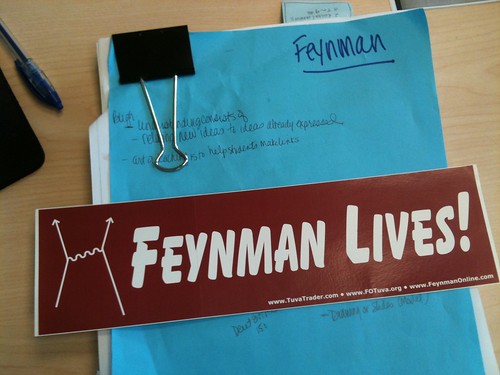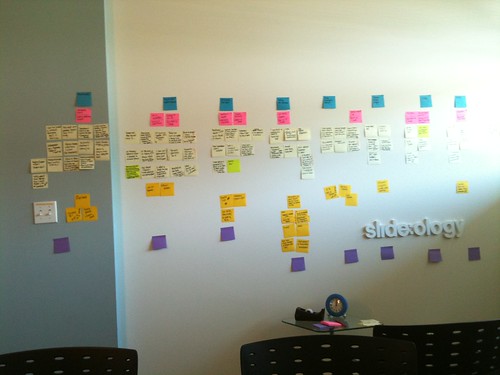For more Gamestorming goodness, check out the Gamestorming blog.
Keep in touch! Sign up to get updates and occasional emails from me.
Keep in touch! Sign up to get updates and occasional emails from me.
In his book Smart Things, Mike Kuniavsky talks about the information shadow as an essential element of a smart thing. The information shadow is the information that's associated with an object such as its name, number, position in space and time, and so on.
Metaphors also help people understand new services by linking the new to the familiar. For example, RFID was first introduced as the next generation of the bar code, even though the two technologies had little in common.
Information shadows allow designers to make objects simpler, to reduce the size of interfaces and reduce the display requirements of an object. An iPod shuffle, for example, can be tiny because the information display resides in iTunes, not on the device.
Science fiction author and futurist Bruce Sterling coined the term spime to describe an object that can be tracked through space and time throughout the lifetime of the object.
This is part of a project called Ubicomp Sketchbook that I initiated with user experience designer Peter Morville, author of Ambient Findability and Search Patterns, in order to explore and explain the ideas aand implications of ubiquitous computing, sometimes called the "internet of things." Check out the whole set.
Please share your thoughts!
Keep in touch! Sign up to get updates and occasional emails from me.
I love my iPad, but the finger-only interface has been a continuing frustration for me. As an artist and designer, I want to do things that I can easily do with a pen and paper, like write, scribble and sketch. But these are not things we typically do with our fingers, any more than we eat soup or salad with our fingers.
Apple apologists will say that you can sketch and write with the iPad, and indeed we can. Yes, and indeed we can also eat salad or even soup without utensils if it's absolutely necessary. But that's not ideal, is it? Over the years we've developed tools, like forks, spoons, knives and yes, pens, that make life easier. We should expect no less from our interface designers.
This morning I participated in a stimulating discussion on twitter with user experience designers @docbaty, @daveixd, @mojoguzzi and @fred_beecher that left me thinking -- could we solve this problem without changing the hardware? And indeed I think we can.
The problem that a pen solves (beyond carrying ink around) is that it gives the user the ability to "see where they are going." Using your finger to draw on the iPad, or even one of the many styli that are available, has the tendency to hide the point of the virtual "pen," thus hiding the path.
Now imagine an interface that allows you to use the natural gesture you use to write with a pen or pencil, and gives you a point that you can see. Suddenly you can see where you are going and the primary problem is solved.
One of the things that occurred to me this morning -- which led to this insight -- was that when Apple first "virtualized" the keyboard by adding it to the software interface instead of the hardware, there was a lot of initial resistance. I was one of those resisters. I couldn't imagine using a phone without a physical keyboard. But over time, I learned to use the virtual keyboard and now I appreciate the additional flexibility that this interface gives me: to have more screen or less as the case demands.
Why not do the same with the stylus? A "virtualized pen" would answer most of my gripes and over time I would probably come to love it. I might even stop carrying a pen and paper around. And that would be an interface I could fall in love with.
Keep in touch! Sign up to get updates and occasional emails from me.
In his book Smart Things, Mike Kuniavsky suggests metaphor as a tool for thinking through ubicomp designs and interactions. By mapping one category onto another we can discover new insights -- among other things, it's a way to trick the mind into seeing old things in new ways.
Organizational metaphors (ways of organizing services) include the factory, the public utility, parallel universes and so on.
Metaphors also help people understand new services by linking the new to the familiar. For example, RFID was first introduced as the next generation of the bar code, even though the two technologies had little in common.
Kuniavsky suggests that when exploring a new concept via metaphor, it pays to explore the dark side as well as optimistic scenarios to get a more well-rounded picture of the future system. How might your design be thwarted? How might the system be hijacked or co-opted for other uses?
Please share your thoughts!
Keep in touch! Sign up to get updates and occasional emails from me.
In a recent post titled Ubuquitous Service Design, Peter Morville raised some interesting questions about how we might design for a world where everything is, or potentially can be -- smart. A world where your refrigerator knows what you had for lunch and when the lettuce will be out of date. A world where your car gives you suggestions for getting better gas mileage or tells you a better way to get where you're going.
In a ubicomp (ubiquitous computing) world, what kinds of methods, and what kinds of tools, will designers use to think through a whole new set of design problems? The environment and the context of use become much more important. Devices and services become stakeholders in the process, communicating not only with users but with other products and processes over a complex and deeply intertwingled network.
How will this change our approaches to design and change? How will it change our lives, our cities, and our social relationships?
Peter and I are embarking on a new project we're calling Ubicomp Sketchbook to explore exactly these kinds of things. We hope you will enjoy the ride and also share your thoughts, sketches and ideas. We'll be using the hashtag #ubicompsketchbook for our explorations.
Keep in touch! Sign up to get updates and occasional emails from me.



Keep in touch! Sign up to get updates and occasional emails from me.
Keep in touch! Sign up to get updates and occasional emails from me.
Keep in touch! Sign up to get updates and occasional emails from me.
Keep in touch! Sign up to get updates and occasional emails from me.
Keep in touch! Sign up to get updates and occasional emails from me.
Keep in touch! Sign up to get updates and occasional emails from me.
"[Ubicomp is] the idea of integrating computers seamlessly into the world at large ... not simulating the world so much as enhancing the one that already exists ... [most of them] will be invisible in fact as well as in metaphor ... These machines and more will be connected in a ubiquitous network.
Today's design challenge, says Kuniavsky, is to create a practice of ubiquitous computing user experience design. Such a practice is by necessity cross-disciplinary, involving identity design (what makes the product or service memorable and unique), interface design (modes of functionality), industrial design (physicality), interaction design (how you can interact with it), information design (how it displays information), service design (how the service maintains consistency across many objects devices and experiences), and information architecture (organizing principles for the information).
That's a lot of D words! In other words it takes a team, and this will only increasingly be the case. The practice is changing quickly, and with the power to transform society comes great responsibility.
Check out the whole set on Flickr, and please share your thoughts in the comments section!